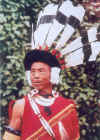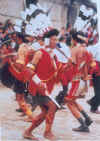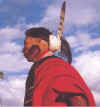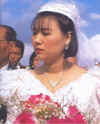|
|
the-south-asian.com June/July 2004 |
||||
|
June/July
2004 Culture
Shamaila
Khan
Lehngas - a limited collection Books Between
Heaven and Hell
|
|
||||
|
‘The Land of the Nagas’ by Avinash Kalla
Nagaland, in India, remained inaccessible to the outside world for ages. The Nagas and their cultural practices have enticed sociologists and anthropologists alike. Their customs, belief system, and mythology are unique to them, despite the influence of Christian missionaries. The Nagas consider the tiger as a brother who later became an enemy. The Naga dress reveals not just the community he or she belongs to but also the social status in terms of wealth and bravery. Naga war ethics allow them to preserve the head of a person killed in a skirmish between two tribes. Author Vibha Joshi and photographer Aditya Arya explored and documented the colourful and mystical lives of the various tribes of Nagaland in their book The Land of the Nagas Author Vibha Joshi and photographer Aditya Arya explored the colourful and mystical lives of the various tribes of Nagaland who have remained largely inaccessible to the outside world. Their new book The Land Of The Nagas is a pioneering work collected over a period of five years and documents the transition taking place in the eastern frontier of India. A cursory glance at the first few pages is enough to grab a reader’s attention. The Land of the Nagas grips one by the sheer beauty of the magnificent pictures that reveal the hidden beauty of Nagaland, its colourful tribes, traditions and its thick forest cover. In a scenic documentation of the state and its people, authors Aditya Arya and Vibha Joshi take the reader through the life cycles of sixteen of the most prominent tribes and sub tribes of the state, which for centuries remained virtually, cut off from the world. It was only in the nineteenth century when the British government extended its administration to the hill state that the world got to know of the Naga tribes. "We have been at the project for the last two decades. Though the book got delayed but still it is a pioneering effort in that it reveals many facets of the Naga life unknown to a majority of Indians. It shows the transition with the coming of Christianity and what remains of the Naga traditions," says Arya. Published in India by Mapin, the pictorial coffee table book unfolds the resplendent festivals and vibrant lifestyles of the Nagas. "They are very warm and hospitable people. I fondly remember the days when there were no mobiles or faxes and one had to rely completely on landlines and postal services. If I got a letter, the villagers would trace me in the dense jungles where I was shooting and deliver it to me."
The highlights of the book are the local festivals brought to life by Arya’s camera. The Tsungrem Mong Festival of the Ao tribe, celebrated in August after the millet has been sown, is actually a prayer for a bountiful harvest. The most important festival of the Angami tribe is Sekrenyi in February every year. The ten-day festivities mark the beginning of the lunar year. To do a book in the region that has been largely inaccessible to the outside world was by no means an easy task. It took numerous visits at different times of the year to capture the true spirit and beauty of Nagaland. L-R:Thatched houses are fast disappearing and being replaced by modern structures; Commonwealth Cemetery on Garrison Hill in capital city Kohima Some of the most striking photographs are those that depict how modernity has seeped into the traditional lives of the Nagas. "You can see change all around. Thatched houses are fast disappearing and being replaced by modern structures. Instead of traditional dresses you have people wearing jeans, trousers, T-shirts and suits. The marriage age of boys has come down from the early thirties to the mid twenties and weddings are solemnized in churches the way they are done in western countries," says Arya. "Of late the traditional dresses are being replaced by Reebok T-shirts and Wrangler jeans - but the festivals are still celebrated in the same spirit." One of the better known features of Nagaland is its handicrafts. "The handicrafts in Nagaland can be put in six broad categories: textiles, bamboo and cane, wood, clay, stone, and metal."
The most important occupation of the Nagas still is basket making. According to the book, there are different kinds of baskets for different purposes. There is one for carrying wood, another one for paddy and yet another for serving rice beer. Each Naga household has at least ten traditional baskets for different purposes. If the baskets haven’t changed, neither has the way a Naga home looks and functions. The external architecture and the interiors of most houses have a striking similarity. One common feature of a Naga household is the fireplace that is kept lit throughout the day. Religious Conversions The roots of Christianity are deep in Nagaland. The authors write, " With the advent of Christianity, the followers of the traditional religion have dwindled in numbers. Less than 20 percent of the present Naga population follows the traditional religion. However, conversion to Christianity has not completely displaced the old beliefs."
Old beliefs and faith are still rampant. For example, according to Naga mythology the tiger was born from the same mother as man but later he was banished to the dark jungles because of his misdeeds. Now whenever some misfortune befalls a village, a massive tiger hunt is launched and continues till one is found and killed. Its skin is still used to decorate the war shield.
But tiger is not the only endangered animal in the region. There is more trouble in paradise. Land disputes are widespread and there are frequent skirmishes that are bloody and gory. Tribesmen preserve the skulls of people they have killed. "These are like war trophies and are kept in the house of the all-powerful Ang (head of the tribe). Interestingly none of them want any outside mediation in their disputes," says Arya. There is a strong demand for self-governance in the region. "These are tribal people who want to live their lives by traditional laws laid down by their forefathers. Their idea of a government ruling their destinies is still not acceptable," says Arya. Recalls Arya, "We travelled to the state for five years trying to get an insight into the life of the Nagas. We’d do our research till our money lasted, come back to Delhi, earn some more money and then go back for more research. Yes, it was tiring but our passion kept us going. In the end we had so many pictures it was hard to choose." And the five-year labour has been well rewarded. The book has been receiving accolades not just from book aficionados but from people who know the state well. The Governor of Nagaland called up Arya to congratulate him. "That was the most satisfying moment for me," says Arya who is already planning a sequel to the book. But, he says, "This time I will make sure it doesn’t take five years to complete!"
***** |
|||||
| Copyright © 2000 - 2004 [the-south-asian.com]. Intellectual Property. All rights reserved. | |||||
| Home | |||||







